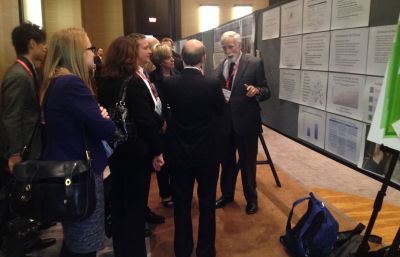
 DALLAS, TX--Robert H. Trenkamp, Jr.< EMT-P, and Fernando J. Perez, MD, of Saving Lives in Chatham County, Georgia, have calculated the gap between the requirements of the AHA chest compression guidelines and the physical capability of 50 individuals. Using chest stiffness data from P. Aelen, et al., they found that on the average, manual compressions would result in guideline-compliant depth in 42 percent of cardiac arrest victims, while compressions delivered with the foot would serve 75 percent of the victims. The accuracy of the estimation algorithm was verified by measuring the actual force 10 individuals were able to generate and comparing it to the algorithm's prediction for those individuals. These findings were reported in their late-breaking abstract, "Physical Shortfalls in CPR Quality and Methods for Improvement," presented at the American Heart Association 2013 Resuscitation Science Symposium.
DALLAS, TX--Robert H. Trenkamp, Jr.< EMT-P, and Fernando J. Perez, MD, of Saving Lives in Chatham County, Georgia, have calculated the gap between the requirements of the AHA chest compression guidelines and the physical capability of 50 individuals. Using chest stiffness data from P. Aelen, et al., they found that on the average, manual compressions would result in guideline-compliant depth in 42 percent of cardiac arrest victims, while compressions delivered with the foot would serve 75 percent of the victims. The accuracy of the estimation algorithm was verified by measuring the actual force 10 individuals were able to generate and comparing it to the algorithm's prediction for those individuals. These findings were reported in their late-breaking abstract, "Physical Shortfalls in CPR Quality and Methods for Improvement," presented at the American Heart Association 2013 Resuscitation Science Symposium.
Pedal compressions had been examined in 1978-1980, but with the far shallower compression guidelines that existed at that time, there was no compelling reason to adopt the method, even though the pedal method resulted in fewer misplaced compressions than did manual compressions. The research Trenkamp and Perez presented at the 2012 Symposium demonstrated that the pedal method also affords greater stamina, thus making it more likely that a bystander can perform compressions until emergency medical services responders take over.
The publication of the 2010 AHA guidelines have essentially doubled the force required to achieve guideline-compliant chest compressions and resulted in fewer people with enough upper body weight to reach the guideline depth. The science behind the two-inch guideline is solid, so changing the guidelines is not a reasonable option.
The authors proposed that pedal compressions become the preferred method of chest compression for bystanders and for healthcare providers in some circumstances such has home healthcare nursing and in doctors' and dentists' offices. They will be evaluating both mechanical compression devices and weighted vests in a study beginning in early 2014 in an effort to further close the gap.
The presentation slides are available at www.slicc.org/ReSS-2013_Final.pdf.
Trenkamp serves on the Advisory Council of the Sudden Cardiac Arrest Foundation.
